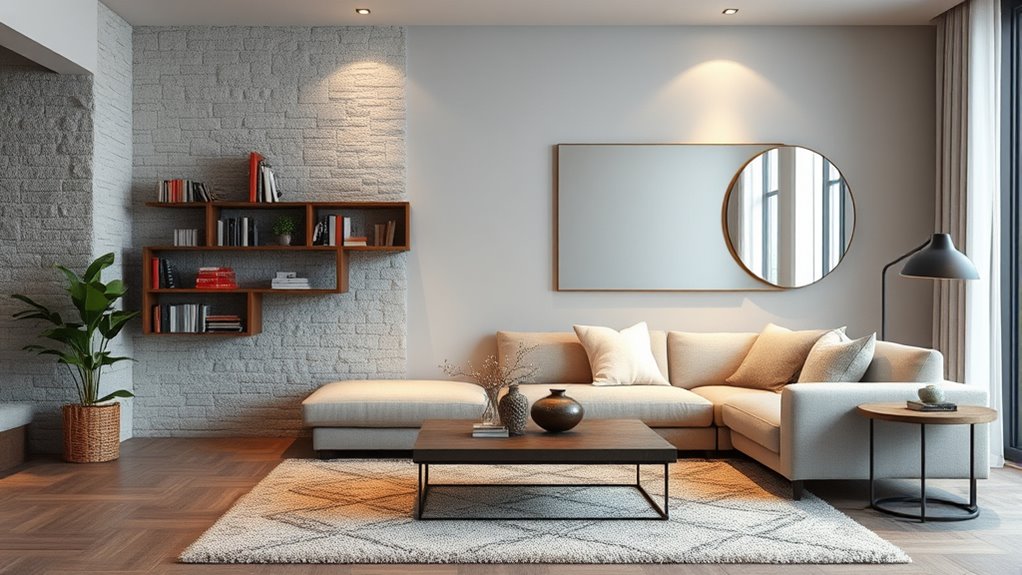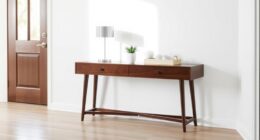To unlock the secret layout tricks interior designers use, start with a detailed floor plan to plan flow and furniture placement. Visualize how each piece fits before buying, ensuring proper proportions and symmetry for balance. Layer textures and use a cohesive color palette to add depth. Incorporate statement items as focal points and arrange everything for ideal function. Keep exploring for more expert tips to transform your space effortlessly.
Key Takeaways
- Starting with a detailed floor plan and visualizing furniture placement before purchasing to optimize space and flow.
- Using proportional scaling and symmetry to create balanced, harmonious room layouts.
- Incorporating focal points and statement pieces to draw attention and add visual interest.
- Layering textures and coordinating colors to enhance depth, warmth, and cohesion.
- Arranging furniture and elements to ensure smooth traffic flow and functional zones within the space.
Starting With a Detailed Floor Plan

Creating a detailed floor plan is the essential first step in designing a functional and attractive interior. Your floor plan serves as the blueprint for your layout, guiding furniture placement and space utilization. Measure each room’s dimensions carefully, including windows, doors, and architectural features, to guarantee accuracy. Use graph paper, digital tools, or design software like SketchUp or Roomstyler to develop precise layouts that reflect your actual space. As you draft your plan, consider traffic flow, functional zones, and focal points to optimize usability and aesthetics. Don’t settle on a single design—draft multiple options to explore different configurations. Incorporate scale models or cutouts of furniture into your floor plan to visualize how each piece will fit and interact within the space. Additionally, understanding space utilization can help you maximize every inch of your layout for both comfort and style. Exploring interior design principles can further enhance the overall harmony and functionality of your space. Incorporating butter-inspired color schemes can add warmth and a touch of artistic elegance to your decor. Remember to keep rustic elements in mind to maintain a cozy farmhouse charm throughout your design process. Integrating sound therapy techniques into your design can also promote a calming atmosphere that enhances well-being.
Visualizing Furniture Placement Before Buying

Once you have a detailed floor plan in place, the next step is to visualize how furniture will fit within the space before making any purchases. This means carefully imagining or even physically testing how different pieces will work together in the room. Use scaled paper cutouts or 3D models to get a realistic sense of flow and proportion. Measuring your space accurately and matching those measurements to furniture dimensions helps prevent buying oversized or undersized pieces. Creating mood boards with color swatches and textures alongside furniture sketches ensures everything works cohesively. Visualization techniques, such as digital room planners, can further enhance your ability to plan effectively. Visualizing furniture placement beforehand reduces impulse buys and helps establish a balanced, functional layout. Incorporating space optimization techniques can further enhance your planning process. Taking these steps allows you to confidently imagine how each piece will enhance your space before committing to a purchase. Additionally, understanding signs of spoilage in materials like fabrics or upholstery can help maintain furniture quality over time.
Using Proportional Scaling for Comfort and Balance

Using proportional scaling guarantees that furniture and accessories fit comfortably within your space, creating a balanced and harmonious room. By sizing pieces relative to the room’s dimensions, you ensure that each element contributes to a cohesive look. Interior designers often measure the space and select furniture that occupies about 60-75% of the floor area, allowing for easy movement and comfort. They also use the rule of thirds, dividing space and elements into thirds to achieve visual interest without overcrowding or sparseness. Carefully considering the height, width, and depth of furniture helps prevent any piece from overwhelming or getting lost. Incorporating varying sizes of decor and furniture within a room enhances visual rhythm, reinforcing the overall sense of balance and comfort in your space. Additionally, understanding the importance of key components in sound design can inspire more thoughtful and harmonious arrangements in your decor choices. Paying attention to proportional relationships between furniture pieces further supports a balanced and inviting environment. Employing asset division principles when selecting and arranging furniture can also contribute to a well-structured and functional space. Recognizing the benefits of self-watering plant pots can also add an element of ease and sustainability to your interior design, promoting healthy plants with minimal effort.
Layering Textures to Add Depth and Warmth

Layering textures is a powerful way to add depth and warmth to your space, making it feel more inviting and dynamic. When you layer different textures like velvet, linen, wool, and silk, you create visual interest and invite tactile engagement. Incorporate textured elements such as boucle or shaggy rugs alongside smooth surfaces like glass or polished metal to add contrast and richness. Using a mix of matte and glossy finishes in your decor amplifies the sense of dimension and sophistication. Strategically placing textured accessories, like woven baskets or textured wallpaper, anchors your design and adds warmth. This thoughtful layering not only enhances depth but also makes your room feel cozy and layered, transforming a flat space into a vibrant, inviting environment. Additionally, understanding cybersecurity vulnerabilities can help protect your digital spaces from disruptions that could impact your home or work environment. Recognizing the importance of personal development tools can further enrich your interior design process by fostering creativity and mindfulness in your space planning. Exploring the psychology of color can also influence how textures and layers are perceived, creating a more harmonious atmosphere. Incorporating ergonomic principles ensures that your space remains comfortable and functional as you layer various design elements. Being aware of lifevest advisors can also guide you towards making secure and informed decisions about your investments in home and lifestyle improvements.
Incorporating Statement Pieces for Visual Interest

Incorporating statement pieces transforms a room from ordinary to mesmerizing by adding focal points that catch the eye. These statement pieces—like bold artwork, sculptural furniture, or dramatic lighting fixtures—immediately draw attention and anchor your design. Using a large piece, such as an eye-catching mirror or colorful accent chair, creates visual interest and adds personality. Statement lighting, like oversized pendant lights or chandeliers, adds drama and serves as a natural focal point. To keep the room balanced, pair bold statement items with more subdued decor, ensuring they stand out without overwhelming the space. Layering these statement pieces throughout the room enhances depth and invites your eye to explore every corner, making your design enchanting and cohesive. Additionally, incorporating eco-friendly materials can elevate the overall ambiance and make your interior truly memorable. For example, choosing sustainable decor options can further enhance the aesthetic while supporting environmentally conscious practices. Incorporating environmentally conscious practices also demonstrates a commitment to sustainability that can resonate with viewers. Introducing statement pieces with unique textures or finishes can also enrich the tactile experience and add sophistication to your space.
Paying Attention to Scale and Symmetry

To create a balanced space, you need to pay close attention to scale and symmetry. Choosing furniture that fits the room’s size and positioning matching pieces on either side of a focal point helps achieve harmony. When you get these elements right, your room will feel both comfortable and visually appealing. Additionally, embracing limits on creativity can inspire innovative solutions for space planning and design choices.
Balance Through Symmetry
Achieving visual balance in your space often involves creating symmetry, which is accomplished by mirroring elements on either side of a central point. Symmetry creates a sense of order and harmony, making your room feel cohesive. To enhance this, use pairs of accessories like matching lamps or art, which reinforce balance. Proper scale is essential—furniture and decor should be proportionate to the room size to avoid clutter or awkwardness. Center larger pieces, such as sofas or beds, and balance them with side tables and lighting to strengthen symmetry. Incorporate consistent proportions and repeating shapes throughout your space to maintain visual unity. This focus on symmetry and scale ensures your room feels balanced, polished, and inviting.
Proper Furniture Sizing
How do you guarantee your furniture fits perfectly in your space? Proper furniture sizing is key. It means choosing pieces that match your room’s dimensions, preventing clutter and awkwardness. For small spaces, scaled-down furniture helps maintain an open, airy feel, while larger rooms can handle more substantial pieces for impact. Symmetry also plays a role; mirroring chairs or side tables creates a balanced look. To get it right, consider these tips:
- Visualize furniture in your room using sketches or digital layouts
- Opt for smaller furniture in tight spaces to avoid crowding
- Ensure each piece is proportionate to the room’s size
- Maintain consistent scale in patterns and accessories for harmony
Paying attention to proper furniture sizing guarantees your space looks balanced, inviting, and perfectly suited to your needs.
Creating a Cohesive Color Palette Throughout

Creating a cohesive color palette throughout your home begins with selecting a few key shades that reflect your inspiration pieces, such as artwork, rugs, or fabric prints. Establish a core color palette by extracting these shades to assure consistency across all rooms. Stick to a limited color scheme—typically three to five main hues—to maintain harmony and prevent visual clutter. Incorporate neutral tones as a base, allowing accent colors to stand out and offering flexibility in decorating different spaces. To enhance cohesion, repeat the primary colors in various rooms, but vary the shades or intensity to add depth and interest. Before making any purchases, visualize your entire home’s color palette using swatches or digital mood boards to guarantee seamless cohesion.
Arranging Elements for Flow and Functionality

Arranging elements for flow and functionality is essential to designing a space that feels both inviting and practical. You want to guarantee traffic flow is smooth, so keep walkways at least 24-36 inches wide for easy movement. Create functional layouts by positioning furniture to foster conversational areas, with seating facing each other and enough space in between. Place frequently used items, like side tables and lamps, within arm’s reach to boost convenience. Use proportionate spacing, such as the golden ratio, to balance elements visually. Additionally, plan zoning clearly to differentiate areas for lounging, working, or dining, enhancing flow and purpose. By focusing on traffic flow and functional layouts, you’ll craft a space that’s both beautiful and highly livable.
Utilizing Digital Tools to Map Out Your Design

Digital tools like Canva, Photoshop, and SketchUp have revolutionized interior design by allowing you to craft detailed floor plans and visual layouts before making any physical changes. These digital tools help you visualize how furniture, colors, and textures will work together, giving you a clear picture of the final look. With precise placement features, you can see how each element fits in scale and proportion, ensuring everything feels cohesive. Digital mockups let you experiment with different arrangements, color schemes, and textures without costly trial and error. Using 3D rendering software provides realistic views of your space, highlighting potential issues early on. Overall, these tools help you visualize your design more accurately, reducing mistakes and boosting your confidence in your choices.
Frequently Asked Questions
What Is the 3-5-7 Rule in Decorating?
The 3-5-7 rule in decorating helps you create balanced, harmonious displays by grouping accessories in odd numbers of three, five, or seven. You’ll find it useful when styling vignettes or centerpieces, as it prevents clutter or emptiness. By arranging items in these groupings, you establish visual rhythm and weight, making your space feel more cohesive and thoughtfully curated. It’s a simple trick to enhance your interior’s overall harmony.
What Is the 70 30 Rule in Interior Design?
The 70/30 rule in interior design guides you to use 70% of neutral or subdued colors in your space, like walls and large furniture, creating a calm foundation. Then, you add bolder or accent colors in the remaining 30%, with accessories and artwork. This balance guarantees your room feels cohesive and inviting without being overwhelming, making your decorating process easier and your space more harmonious.
What Is the 60 40 Rule in Interior Design?
Did you know that most successful interior designs follow the 60/40 rule? In this approach, you should use 60% neutral or subdued tones and 40% bolder colors or patterns. This balance keeps your space feeling calm yet lively. You can achieve this by mixing paint, furniture, textiles, and decor. It helps you create a harmonious, layered look that feels intentional and sophisticated, especially if you’re just starting out.
What Are the 7 Basics of Interior Design?
You want to understand the 7 basics of interior design. These include line, shape, form, space, texture, pattern, and color. Line guides the flow and mood, while shape and form define the structure. Space guarantees balance and functionality. Texture, pattern, and color add interest and depth. Mastering these elements helps you create a harmonious, inviting space that reflects your style and meets your needs effectively.
Conclusion
By mastering these layout tricks, you’re like an artist with a paintbrush, shaping your space into a stunning masterpiece. Visualize your plan, layer textures, and balance elements to create a harmonious environment. Use digital tools to refine your design, ensuring every piece flows seamlessly. With intention and creativity, you’ll transform any room into a cozy, stylish haven that feels just right—like a perfectly tailored suit that fits you perfectly.









